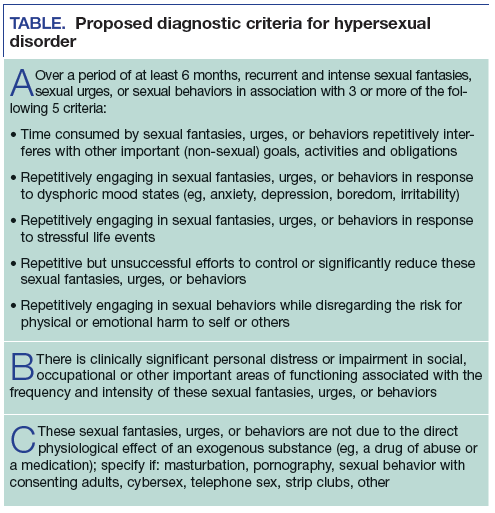Publication
Article
Psychiatric Times
Sex Addiction: Playing Now in Theaters
Author(s):
After the recent escalation of sexual scandals, the term "sex addiction" has come to the forefront.
TABLE. Proposed diagnostic criteria for hypersexual disorder

Dr. Zanzonico is a PGY4 Resident, St. Elizabeth’s Medical Center, Tufts University School of Medicine; Dr. Sorrentino is Assistant Professor, Massachusetts General Hospital, Harvard Medical School, Boston, MA.
After the recent escalation of sexual scandals, a growing number of Hollywood celebrities have sought treatment in sex addiction rehabilitation centers.
While the media presents sex addiction as a recognized psychiatric entity, mental health professions debate the validity of the diagnosis.1 A controversial disorder that has not yet made its way into DSM-5, sex addiction is estimated to affect between 3% and 6% of the population, and has recently become the label associated with various kinds of sexual misconduct, cited by Michael Douglas to justify his infidelity or by Harvey Weinstein in response to accusations of sexual harassment and abuse.2
The question of whether the term “sex addiction” should be applied to these cases remains unclear as the concept of sex addiction, including diagnostic criteria and treatment options, is not widely accepted by the psychiatric profession. In recent years, efforts have been made to conceptualize sex addiction. Kafka proposed diagnostic criteria for hypersexual disorder (HD), presented as a non-paraphilic sexual disorder with an impulsivity component.3 In the description by Kafka (Table), persons with HD display an uncontrolled urge to engage in repetitive sexual behaviors (from cybersex to pornography), often in response to dysphoric states or stressful life events, and experience distress or impairment in function.
HD was a new disorder proposed for inclusion in DSM-5. However, the diagnosis was rejected because of the lack of a general consensus in the psychiatric field. This month the International Institute for Trauma and Addiction Professionals published a position statement on sexual addiction that stated: “sexual and compulsivity is a very real problem . . . supported by over 30 years of research in addiction medicine and an abundance of neuroscience studies.”4
Assuming the compulsive behavior associated with sex can resemble the characteristics of addiction, the scientific community has been reluctant to attribute the term to a problematic behavior. Gambling disorder and binge eating disorder are the only 2 compulsive behaviors included in DSM-5, and the term addiction has not (yet) been used in their conceptualization. Such hesitation may arise from the fear of pathologizing normative behavior. The reluctance of the scientific community to recognize sex addiction may also be influenced by social norms. For example, BDSM (bondage-discipline, dominance-submission, sadism-masochism) ceased to be a psychiatric disorder only in 2010, and was excluded from DSM-5, which suggests that there are sexual preferences and sexual disorders that are still poorly understood.
On a more practical level, clinicians have been treating patients with impulsive and self-destructive sexual urges not better explained by the use of a substance or another Axis I disorder for decades. In the absence of diagnostic criteria and guidelines for treatment, clinicians have been prescribing SSRIs, and in refractory or dangerous sexual behaviors, hormonal agents such as leuprolide (chemical castration). Non-pharmacological interventions have been adapted from 12-step methodology (eg, Sex Addicts Anonymous), cognitive behavioral therapy, and psychodynamic psychotherapy.5 A holistic approach that combines psychopharmacological treatment, personal and group therapy, as well as mind-body activities, is the formula of many (luxury) sex addiction clinics, offering both outpatient and residential programs.
The media has recently presented sex addiction clinics in relation to Hollywood celebrities undergoing treatment.6 From 1-week intensive treatment to 1 month of therapy, the media may have given an altered idea of addiction and recovery. Whether the term sex addiction has been inappropriately used to explain sexual offending behavior, the media has presented sex addiction as the easy way out when the alleged sufferer is caught engaging in any form of sexual misconduct. Such simplistic description may not represent fairly the many troubled patients, still lacking a formal diagnosis, who are undergoing treatment. While the media may not give an adequate representation of (still debated) sex addiction, it has revealed the flaws of the scientific community regarding the ongoing discussion on sexual preference and sex disorders, possibly fueling renewed interest in this controversial topic.
The authors report no conflicts of interest concerning the subject matter of this article.
References:
1. Kor A, Fogel Y, Reid RC, Potenza MN. Should hypersexual disorder be classified as an addiction? Sex Addict Compulsivity. 2013. https://www.ncbi.nlm.nih.gov/pmc/articles/PMC3836191/. Accessed December 13, 2017.
2. Black DW. The epidemiology and phenomenology of compulsive sexual behavior. CNS Spectr. 2000;5:26-72.
3. Kafka MP. Hypersexual disorder: a proposed diagnosis for DSM-V. Arch Sex Behav. 2010;39:377-400.
4. Cision. Position Statement From the International Institute for Trauma and Addiction Professionals. December 2017. http://www.prweb.com/releases/2017/11/prweb14920504.htm. Accessed December 13, 2017.
5. Kaplan MS, Krueger RB. Diagnosis, assessment, and treatment of hypersexuality. J Sex Res. 2010;47:181-198.
6. Mulkerrins J. Where celebrity sex addicts get “treatment”: The Meadows, Arizona. http://www.afr.com/lifestyle/boot-camp-for-the-worlds-most-famous-sex-addicts-20171113-gzkmgw. Accessed December 13, 2017.







